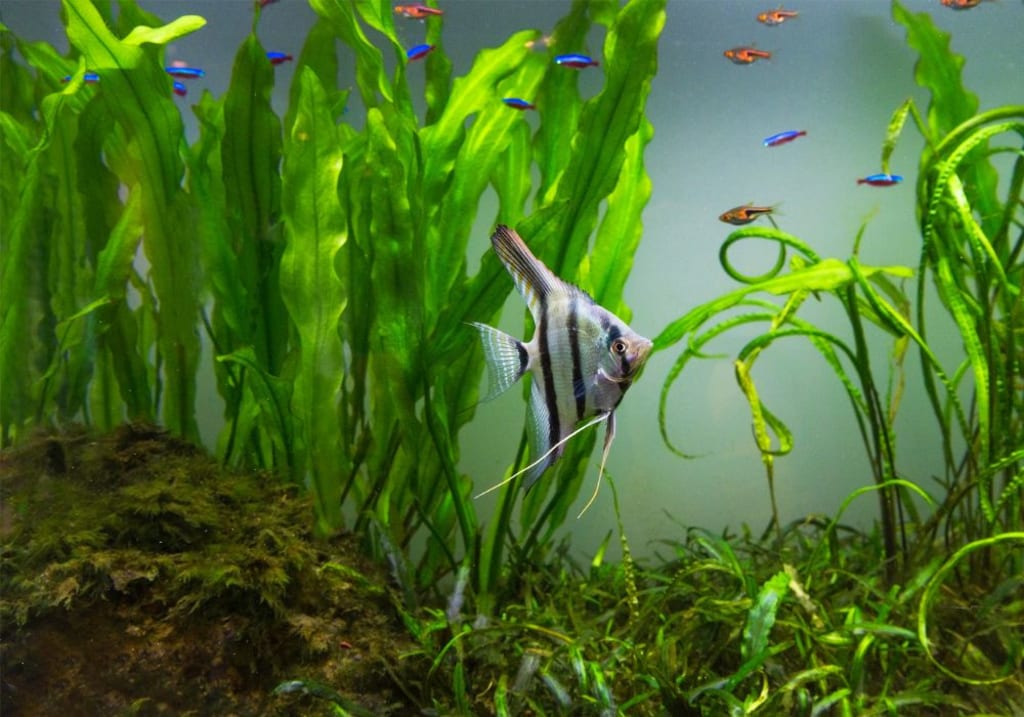Choosing the Best Plants For Your Fish Tank
An Introduction to Aquatic Plant Care

Overview of Aquatic Plant Care: What You Need to Know
When setting up a fish tank, choosing the right plants is just as important as selecting the correct fish. Having the wrong type of plants can cause problems for your tank's inhabitants, and can even cause the plants to die. The best plants for a fish tank are those that require little maintenance and are compatible with the other tank inhabitants. Here is an overview of aquatic plant care and what you need to know when choosing the best plants for your fish tank.
Research Your Options
Before purchasing any plants for your fish tank, it is important to research which ones would work best in your setup. Start by familiarizing yourself with the different types of aquatic plants available and their individual care requirements. Consider factors such as light, temperature, water hardness, and pH balance. Different species of aquatic plants require different levels of light, so make sure you know which species prefer low or high light levels. Additionally, check whether or not they need fertilizers or supplemental CO2.
Choose Plants That Are Compatible With Fish
After researching your options, select aquarium plants that are compatible with the other inhabitants in your tank. Not all aquatic plants are safe for use with fish so it’s important to choose wisely. There are many varieties of aquatic vegetation that do not support a healthy environment for some species of fish. For example, some popular aquarium decorations such as Java moss or Java ferns can provide hiding places but can also catch on fins and gill plates and should therefore be used with caution.
Maintenance Tips
It is important to keep up with regular maintenance when caring for aquarium plants. To maintain a healthy environment for your fish and other inhabitants it is necessary to regularly clean out debris from between plant leaves using tweezers or an algae scraper. Also inspect regularly for signs of disease such as discoloration or wilting leaves; if diseased remove immediately.
Conclusion
Choosing the best plants for a fish tank takes some research and careful consideration. Researching individual requirements such as lighting conditions and compatibility with other species in your tank will help you create an optimal living environment suitable for all inhabitants. Additionally, keeping up with regular maintenance tasks like cleaning debris from between plant leaves will help ensure a healthy habitat.
Benefits of Adding Plants to Your Fish Tank
Adding plants to your fish tank is beneficial for the entire ecosystem. Not only do they look aesthetically pleasing, but they also help reduce the amount of algae in your tank and provide shelter for your fish. When selecting the best plants for a fish tank, it's important to consider factors such as lighting, water temperature, and source of nutrition.
Lighting Requirements
The type of lighting you use will greatly influence which plants you decide to use in your aquarium. Depending on the type of light you have, some species may require more or less light than others. Generally speaking, low-light plants such as Anubias and Java ferns require about 1-2 watts per gallon while medium-light plants require 2-4 watts per gallon. Highlight plants like aquatic lilies and Alternanthera will need 4-7 watts per gallon.
Temperature and pH Requirements
When choosing the best plants for a fish tank, it’s important to consider water temperature and pH levels as well. Some species prefer warmer temperatures while others prefer cooler temperatures. Additionally, different plants prefer different pH levels ranging from acidic to alkaline conditions. Be sure that whatever type of plant you choose is compatible with the temperature and pH levels in your aquarium before adding them to your tank.
Nutrition Source
Most aquarium plants rely on fertilizers or supplemental CO2 for nutrition, however some species are able to survive without any additional nutrients due to their ability to absorb nutrients from their surrounding environment (such as nitrates). If you opt for a low-tech setup with no supplement fertilizers or CO2 injection, be sure that whatever type of plant you choose can thrive without additional nutrients in order for it survive long term in your aquarium. In conclusion, when selecting the best plants for a fish tank it’s important to consider factors such as lighting requirements, water temperature and pH levels as well as the source of nutrition required by each species. By taking these into account you’ll be able to find the perfect aquatic plant that fits into both your aesthetic preferences and ideal water conditions for a healthy ecosystem!
Choosing the Right Plants for Your Fish Tank
When it comes to selecting the best plants for your fish tank, there are a few things to consider. Firstly, you need to think about the environment within your tank – what kind of habitat are you creating? Is it tropical or cold water? Secondly, you need to take into account the size of your aquarium and what kind of plants will best fit in with the current set-up. Finally, and most importantly, you must ensure that you choose plants that are safe for fish, as some aquatic plants can be toxic if ingested by them. When selecting the right plants for your fish tank, it is important to remember that different types of plants require different amounts of light and care.
Some low-maintenance aquatic plants can thrive in dimly lit tanks while others require more light and attention. It is also important to be aware of which water parameters the plant thrives in; if the water conditions do not match, then this could lead to problems with growth or even death for certain species. Some popular options for fish tanks include Java moss, Anubias Nana, Cryptocoryne Wendtii, Hornwort and Java Ferns. Java moss is an excellent choice as it is easy to care for and looks great in any aquarium thanks to its lush green appearance. Anubias Nana is also a popular choice due its low-light requirements and slow growth rate – perfect for a busy hobbyist who doesn’t have time to maintain a large tank every day!
Cryptocoryne Wendtii is another great option as its vibrant reddish-brown colour makes it stand out amongst other aquatic plants. Hornwort makes an excellent addition due to its fast growth rate; however, it should be noted that this plant tends to spread quickly so it may not be ideal if you have limited space in your tank! Lastly Java Ferns make an excellent choice as they are well known for their hardiness; they can tolerate a wide range of temperatures and conditions so they are perfect if you are looking for something low maintenance.
Tips for Plant Care and Maintenance
When it comes to a fish tank, choosing the best plants for it is key to a healthy environment. To ensure the longevity of your aquatic plants, you'll need to consider a few factors: the type of fish living in the aquarium, the size of the tank, and light availability. In this article, we'll explain what you should consider when selecting plants for your fish tank and provide some helpful tips on plant care and maintenance.
The Best Plants for a Fish Tank
When selecting plants for an aquarium, it's important to consider the type of fish living in the tank. Different species of fish prefer different types of vegetation, so do research on what types of plants are best suited for your particular species of fish. For instance, mollies prefer low-light plants such as Java moss or Anubias while tetras prefer more brightly lit areas with larger vegetation such as Hornwort or Amazon swords. It's also essential to choose plants that don't require large amounts of light as too much light can cause algae growth in an aquarium which can harm your fish.
It's also important to select plants that are suitable for your tank's size. If you have a small tank, opt for smaller varieties such as Dwarf Baby Tears or pearlweed which won't take up too much space. For larger tanks, you can choose taller varieties like Jungle Val or Water Wisteria which will provide extra oxygenation and create an interesting landscape. Finally, make sure that you pick plants that require similar lighting levels since this will help maintain balance in your aquarium's ecosystem.
For example, if you opt for low-light tolerant vegetation such as Anubias or Java Ferns then avoid pairing them with high-light demanding species like Water Wisteria or Amazon Swords since this could disrupt water chemistry in your aquarium which could lead to algae overgrowth and potentially injure or kill your fish.
Plant Care & Maintenance Tips
Once you've chosen the best plants for your fish tank, taking care of them is essential to their longevity and health. Here are some helpful tips:
- Keep an eye out for pests such as snails and algae - these can easily spread throughout an aquarium if not kept in check.
- Think about supplementing CO² levels if necessary - this will help encourage strong growth in certain types of aquatic vegetation.
- Provide adequate fertilizers - regular fertilization helps keep nutrients balanced so aquatic organisms thrive.
- Trim regularly - trimming back aquatic vegetation helps keep it from obstructing other elements in the aquarium.
- Avoid overcrowding - there needs to be enough space between each individual plant so they all have access to air and light.
Taking proper care of aquatic plants is essential to keeping a healthy environment in an aquarium – with the right type of vegetation selected based on its suitability for both your tank size and type(s) of fish living there; coupled with regular maintenance (e.g., pest control/eradication; fertilization & trimming) you'll be able to enjoy watching lush aquatic greenery thrive!
About the Creator
Hasan
Welcome...
In this site of mine you can learn amazing things and many information that you don't know so please subscribe to my site.
Enjoyed the story? Support the Creator.
Subscribe for free to receive all their stories in your feed. You could also pledge your support or give them a one-off tip, letting them know you appreciate their work.






Comments
There are no comments for this story
Be the first to respond and start the conversation.